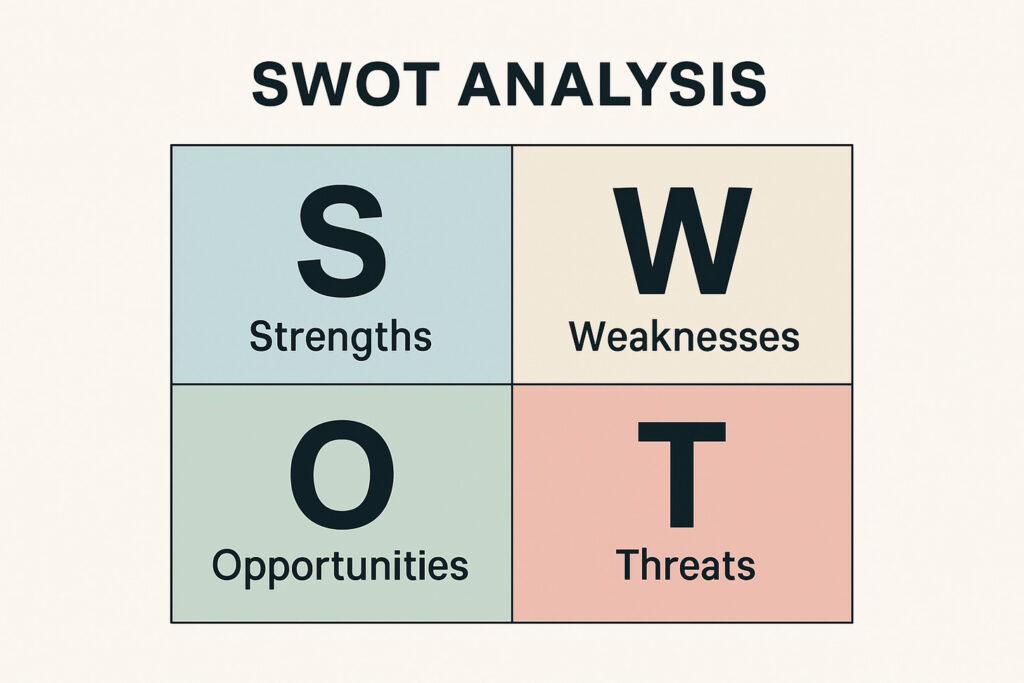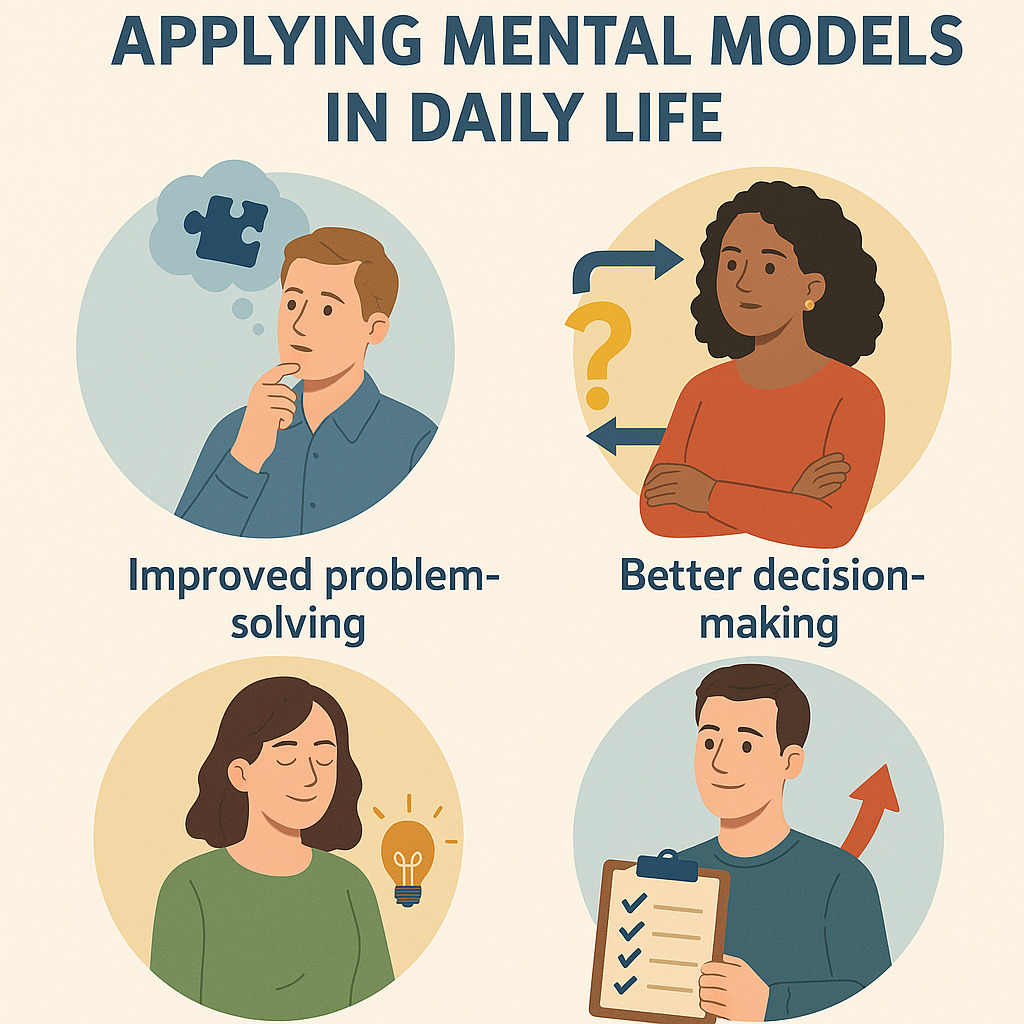What are benefits of applying mental models in daily life? Ever feel overwhelmed by choices or stuck solving the same problems? Imagine having a toolkit that helps you cut through complexity. That’s exactly what mental models offer—a way to simplify how you approach decisions, big or small. These mental models serve as a lens through which you can evaluate your options and enhance your productivity.
Think of these frameworks as “cheat codes” for your brain. They turn messy real-world situations into clearer patterns. For example, using the 80/20 rule helps identify which tasks actually drive results. Other models like inversion (“flipping” problems) reveal blind spots in your thinking and help you avoid biases that can lead to errors in judgment.
This article will show you how to spot hidden opportunities in daily challenges, avoid common decision traps, and save time by focusing on what matters. By recognizing patterns in your decision-making processes, you can uncover opportunities that may have previously gone unnoticed.
For instance, when faced with a difficult choice, applying a mental model like the Pareto Principle can help you identify which factors will yield the greatest results. Additionally, understanding common decision traps, such as confirmation bias or the sunk cost fallacy, can empower you to make more rational decisions.
By using mental models as a lens to evaluate information, you can enhance your productivity and find solutions to everyday problems.
Key Takeaways
- Mental models act like decision-making shortcuts for people navigating complex choices
- They simplify complex information into usable patterns that help think through various scenarios
- Popular frameworks include Occam’s Razor and Second-Order Thinking, which are essential mental models
- Regular practice builds sharper critical thinking skills, helping to avoid biases and errors in decisions
- Works for career choices, finances, and personal relationships, improving the way we allocate resources
Ready to see how these tools transform ordinary moments into smarter choices? Let’s dive into practical ways to make them work for you.
Understanding Mental Models
How do you navigate a new city without a map? You’d likely miss shortcuts or take wrong turns. Mental models work similarly—they’re frameworks that help people interpret the world. Like a GPS for your thoughts, these mental models simplify complex information into patterns you can act on, aiding in decisions and helping a person understand the system around them.
Your Brain’s Toolkit
These models act as filters. They help you separate noise from what matters. For instance, when choosing a job offer, you might use second-order thinking to ask: “What happens three steps later?” This prevents rushed decisions based on surface-level perks.
Shaping Everyday Choices
Imagine planning a weekend trip. You unconsciously use mental models like cost-benefit analysis or time optimization. Experts like Shane Parrish compare them to Swiss Army knives—versatile tools for different situations. They reveal hidden assumptions in your thinking, like assuming more options always lead to better outcomes in your decision-making process.
Here’s the key: Your brain naturally creates shortcuts. Structured mental models make those shortcuts reliable. They help a person turn messy problems into clear paths, whether you’re budgeting groceries or negotiating a contract. It’s not about having all the answers—it’s about asking better questions to avoid biases and errors in your thought process.
What Are Mental Models?

Ever tried assembling furniture without instructions? You’d likely mismatch parts or miss steps. Mental models work like those missing guides—they turn tangled ideas into clear action plans. Think of them as simplified blueprints for navigating the real world.
Simple Representations of Complex Concepts
Our brains crave simplicity. A map isn’t the actual city, but it shows key routes. Similarly, models like Occam’s Razor suggest the simplest solution often works best. A teacher might use this when grading essays: focus on core arguments instead of every typo.
Everyday Applications and Examples
Imagine grocery shopping on a budget. You instinctively compare prices per ounce—that’s cost-benefit analysis in action. Engineers use “margin of safety” to build bridges that handle unexpected weight. These mental models and frameworks turn abstract problems into solvable puzzles that help people make better decisions.
Even texting a friend involves models. You predict their response (second-order thinking) before hitting send. It’s not about perfection—it’s about creating clarity in a noisy world. Like a flashlight in a dark room, these mental models and tools reveal paths you might’ve missed, helping you navigate the complexities of information and biases.
Benefits of Applying Mental Models in Daily Life
Stuck deciding between options that all seem equally good? Structured frameworks help cut through the fog. These thinking tools transform overwhelming scenarios into actionable steps, whether you’re planning meals or negotiating salaries.
From Confusion to Confidence
Imagine comparing phone plans. Without a system, you might fixate on unlimited data while ignoring hidden fees. Using cost-benefit analysis, you’d calculate total yearly costs instead. This approach helped one freelancer save $1,200 annually by switching providers.
Breaking Down Big Challenges
Complex projects become manageable when divided. A project manager might use the 80/20 rule to focus on tasks impacting client satisfaction. Result? Her team delivered prototypes 40% faster last quarter.
| Situation | Framework Used | Result |
|---|---|---|
| Budget Planning | Zero-Based Budgeting | 15% more savings monthly |
| Team Conflicts | Circle of Influence | 75% faster resolutions |
| Career Move | Regret Minimization | Promotion within 8 months |
Notice how each example ties clarity to measurable outcomes? That’s the power of intentional thinking and using mental models. You start spotting patterns that people miss—like realizing most workplace delays stem from just two recurring biases. Suddenly, growth becomes a side effect of smarter daily habits, helping you think about decisions in a new way.
Identifying and Overcoming Cognitive Biases

Ever wonder why smart people make questionable choices? Our brains often trick us using shortcuts called cognitive biases. These hidden patterns distort how we see facts and make decisions—like wearing foggy glasses without realizing it.
Common Blind Spots We All Share
Three biases trip up both kitchens and boardrooms:
| Bias | Personal Impact | Professional Impact |
|---|---|---|
| Confirmation Bias | Only noticing news that matches your views | Hiring candidates who think like you |
| Anchoring Effect | Overpaying because the first price seemed “cheap” | Setting budgets based on last year’s numbers |
| Sunk Cost Fallacy | Finishing bad movies because you paid for tickets | Keeping failing projects alive |
Sharpening Your Thinking Tools
Try these tactics to spot hidden assumptions:
- Play “devil’s advocate” with your own ideas to refine your mental model
- Ask “What would prove me wrong?” before making decisions
- Use checklists to catch common errors
A marketing team once avoided a $50k mistake using premortem analysis. They imagined their campaign had failed—then fixed the weak points beforehand. Structured mental models like inversion (“flip the problem”) help challenge gut reactions and improve the way we think about information. It’s like having a friendly coach point out your blind spots.
Tools for Effective Problem-Solving
Hit a roadblock in your problem-solving process? Structured thinking tools turn messy challenges into clear paths. Let’s explore two powerhouse methods that help teams and individuals crack tough issues.
Brainstorming Techniques
Traditional brainstorming often drowns in chaos. Try these focused methods instead:
- Mind mapping: Start with a central idea, then branch out like tree roots
- Reverse brainstorming: Ask “How could we make this problem worse?” to uncover hidden fixes
- Six Thinking Hats: Role-play different perspectives (optimist, critic, realist)
| Technique | Best For | Outcome |
|---|---|---|
| Mind Mapping | Visual thinkers | Connects scattered ideas |
| Reverse Approach | Stubborn issues | Reveals overlooked solutions |
| Six Hats | Team conflicts | Balances emotional/logical views |
Analytical Frameworks in Action
Once ideas flow, use models to test them. A software team recently combined Richard Feynman’s approach (explain concepts simply) with SWOT analysis. Result? They spotted 3 security risks early in development.
Popular frameworks include:
- 5 Whys: Drill down to root causes
- Decision Matrix: Score options objectively
- Second-Order Thinking: Ask “And then what happens?”
As structured frameworks show, the right tools turn guesswork into strategy. One project manager told me: “It’s like having X-ray vision for hidden bottlenecks.”
Exploring the Ladder of Inference

Why do two people see the same event but draw opposite conclusions? The Ladder of Inference explains this perfectly. It’s a mental model showing how we climb from raw facts to beliefs—often without realizing it. This model helps people understand the way we make decisions based on our interpretations of things. Picture a ladder where each rung represents a step in your thinking process.
Understanding the Six Steps
Let’s break down how this works at a coffee shop. You notice a coworker ignoring your greeting (step 1: observe data). Your brain selects details—their frown, not their busy hands (step 2: filter). You assume they’re upset (step 3: add meaning). Memories of past conflicts surface (step 4: interpret). You decide they dislike you (step 5: conclude). Next time, you avoid them (step 6: act).
Most jumps happen in seconds. The danger? Skipping rungs. Maybe they were just distracted by a deadline. This model helps you pause and check each step.
Practical Applications in Real Life
Imagine reviewing a project delay. Instead of blaming the team, use the ladder. Start at the bottom: What data do you have? Meetings missed? Emails unanswered? Climb slowly. Ask: “Did I filter out positive signs?” or “Are my assumptions based on facts?”
A sales manager used this to fix communication gaps. By mapping her team’s decision process, she found missed client details at step 2. Fixing that boosted accuracy by 30% in three months.
Try it next time tensions rise. Retrace your mental climb. You’ll spot where logic veered off course—and find better paths forward.
Use the 5 Whys Method to Find Root Causes

Ever fix a leak only to have it burst again days later? The 5 Whys Method helps dig past surface-level solutions to find what’s really causing issues. Developed by Toyota’s engineers, this approach reveals hidden patterns through persistent questioning—like peeling an onion layer by layer.
Breaking Down Problems Step-by-Step
Start with a clear problem statement. Let’s say your team misses deadlines. Ask “Why?” five times:
| Question | Answer | Level |
|---|---|---|
| 1. Why deadlines get missed? | Tasks take longer than planned | Symptom |
| 2. Why do tasks drag? | Last-minute client changes | Surface cause |
| 3. Why changes come late? | No clear approval process | Process gap |
| 4. Why no process exists? | Never formalized workflows | Structural issue |
| 5. Why not formalize earlier? | Assumed small team didn’t need it | Root cause |
See how each “why” drills deeper? What started as a scheduling problem revealed a need for documented procedures.
Implementing the Method in Your Workflow
Try this during your next team retrospective:
- Write the issue on a whiteboard
- Ask “why” until you hit fundamental causes (usually 5-7 times)
- Circle the deepest reason—that’s your action point
A bakery owner used this framework to solve recurring dough shortages. The fifth “why” exposed a faulty inventory app—not careless staff. Fixing the tech saved 3 hours daily.
Why does this work? It forces us to challenge assumptions. Instead of blaming people, we examine systems. That shift in thinking turns band-aid fixes into lasting solutions.
Using the Pareto Principle for Efficiency

Ever notice how some tasks create ripple effects while others barely make a splash? The Pareto Principle explains this imbalance: 80% of outcomes often come from just 20% of efforts. This mental model helps redirect your energy toward what truly moves the needle in your decision-making process.
Identifying the Vital Few
Start by tracking where results actually come from. A bakery owner discovered 73% of profits came from 3 specialty breads. She reallocated resources to promote those items—sales jumped 22% without extra work. Look for patterns in your own workflow: Which clients, tasks, or habits deliver disproportionate value?
Prioritizing High-Impact Actions
Tim Ferriss famously used this principle to streamline his business. He focused on the 20% of clients driving 80% of revenue, freeing time for strategic growth.
Apply this to daily decisions:
- Schedule creative work during peak focus hours
- Automate or delegate low-impact chores
- Cut meetings that lack clear agendas
A tech startup applied this by analyzing user feedback. They found 15% of features caused 85% of customer delight. Shifting energy there boosted retention rates faster than adding new tools.
The point? Work smarter by honoring the 80/20 truth—not everything deserves equal attention.
Conducting a Personal and Business SWOT Analysis

Ever faced a crossroads where every path seems equally uncertain? A SWOT analysis acts like a decision-making flashlight. This framework helps you map strengths, weaknesses, opportunities, and threats—whether planning a career shift or expanding a startup.
Assessing Strengths and Weaknesses
Start by listing what you or your business does exceptionally well. A graphic designer might note their speed with Adobe tools. Next, confront weaknesses honestly. Do missed deadlines stem from poor time management?
| Area | Personal Example | Business Example |
|---|---|---|
| Strengths | Public speaking skills | Loyal customer base |
| Weaknesses | Difficulty saying “no” | Slow inventory turnover |
Ask: “What unique skills do others compliment you on?” and “Where do I often need help?” This process turns vague feelings into actionable information.
Spotting Opportunities and Threats
Look outward next. A freelancer might notice growing demand for AI-themed illustrations. Threats could include new competitors undercutting prices. One bakery owner spotted a threat when a grocery chain nearby started selling artisan bread, highlighting the importance of mental models in understanding market dynamics.
Try this exercise monthly. Update your SWOT as circumstances change. You’ll start seeing patterns—like realizing most growth chances align with your core strengths. This mental model is essential for making informed decisions and helps you think about the things that matter in your day-to-day operations. It’s like having a living map for navigating life’s twists.
The OODA Loop for Agile Decision-Making

Racing drivers make split-second choices
Start by gathering raw data without judgment. A nurse might notice a patient’s dropping oxygen levels (Observe). Next, Orient—filter information through experience and context. Is this normal recovery or an emergency?
This process helps people use mental models to make informed decisions about the problem at hand, considering the resources available and the market dynamics that may change over time.
| Step | Key Question | Real-World Example |
|---|---|---|
| Observe | What’s happening now? | Sales drop after price increase |
| Orient | What patterns matter? | Loyal customers still buying |
| Decide | Best option available? | Offer loyalty discounts |
| Act | Immediate next step? | Launch email campaign |
Decision and Action in Practice
Time-sensitive decisions thrive with this approach. A project manager used OODA when clients changed requirements mid-sprint. By reorienting to new priorities within hours, her team delivered on time.
Try these tips to build an agile mindset:
- Set 2-minute observation windows before meetings
- Use checklists for orientation (past data, expert advice)
- Practice “decision sprints” with 15-minute time limits
Remember: The loop never stops. After acting, you immediately observe results—creating a cycle of continuous improvement. Like updating GPS directions during a road trip, it keeps you moving toward goals despite detours.
Diverse Mental Models for Holistic Thinking

What if one map isn’t enough to navigate unfamiliar terrain? Just as explorers layer multiple maps for accuracy, combining mental models creates a richer understanding of complex situations. This approach helps avoid tunnel vision—like using GPS alongside weather reports for safer travel.
Building Stronger Frameworks Together
Urban planners mix traffic flow models with community needs assessments. They might pair the Pareto Principle (focusing on high-impact areas) with SWOT analysis. Result? Parks get built where they reduce congestion and boost neighborhood well-being, helping people make better decisions in the market.
Consider a startup choosing office space. Using cost-benefit analysis alone might prioritize cheap rent. Add second-order thinking: “How will this location affect hiring?” Blend with circle of competence: “Do we understand local zoning laws?” Suddenly, the best option becomes clear in the long term.
Mixing models sparks creative solutions. Teachers combine growth mindset ideas with spaced repetition techniques. Students learn faster because the methods reinforce each other. It’s like having a toolbox instead of a single wrench—you fix problems others can’t even diagnose, pointing out potential errors in their approach.
No single framework holds all answers. But layered thinking helps spot connections between seemingly unrelated challenges and things that may not be obvious at first. You start solving puzzles before others finish identifying the pieces.
Advanced Mental Models for Complex Problem-Solving

Ever feel like complex problems are jigsaw puzzles missing half the pieces? Advanced mental models act like magnifying glasses—they reveal hidden connections between scattered fragments. These frameworks help untangle issues that seem impossible at first glance.
Linear vs. Non-Linear Thinking
Linear thinking follows step-by-step logic, like solving math equations. It works for predictable tasks—think baking a cake. Non-linear approaches thrive in chaos and help think through complex decisions. Imagine a tech startup pivoting after user feedback disrupts their original plan, pointing out potential errors in their system. Both methods matter in the market, but pairing them unlocks breakthroughs.
Balancing Competition and Cooperation
A gaming company blended rivalry and teamwork to solve a coding bottleneck. Developers competed to create the fastest algorithm, then shared top ideas for collective refinement. This mix of “race and relay” cut project time by 35%, helping people in the market to understand the system better and avoid errors in their processes.
Enhancing Focus While Encouraging Creativity
Structured freedom works best. A design team uses “deep work” mornings for focused tasks and “open canvas” afternoons for brainstorming, which help think through complex things. Tools like time-blocking protect concentration, while random idea generators spark innovation in the system. One engineer credited this balance for her patent-winning battery design.
Advanced models aren’t about complexity—they’re clarity tools that help think about the market. Like a chef pairing knives for different cuts, they help you dissect problems with precision. Start small: Apply one framework weekly, then layer more as your mindset grows, minimizing the chance of error in your approach over time.
Mental Models for Career and Growth

What if your next career leap felt less like a gamble and more like a calculated step forward? Structured thinking tools help you align choices with your deepest values while avoiding costly missteps. Let’s explore three frameworks that turn uncertainty into strategic growth.
Defining Your Circle of Competence
A graphic designer once told me: “I kept chasing 3D animation gigs until I realized my true superpower was logo simplicity.” That’s the circle of competence in action—knowing where your skills shine brightest. Warren Buffett credits this mental model for avoiding tech investments during the dot-com boom. Ask yourself:
- What tasks make time fly for me each day?
- Where do colleagues seek my advice in this system?
- Which projects drain my energy vs. fuel it? At this point, consider the things that contribute to your overall success and avoid any potential error in your choices.
| Action | Outcome |
|---|---|
| Focusing on UX design | 35% faster project completion |
| Declining data analysis roles | Reduced work stress by 40% |

Employing the Regret Minimization Framework
Jeff Bezos used this when leaving his Wall Street job to start Amazon. He asked: “Will I regret not trying this at 80?” A teacher applied it recently—she declined a high-paying admin role to keep mentoring students. “The pay cut stung,” she admits, “but watching them graduate? Priceless.”
Try this exercise:
- Project yourself 10 years into the future
- List potential regrets for each option
- Choose the path with least lifelong “what ifs”
Harnessing Incentives for Motivation
A freelance writer I know rewards herself with beach walks after hitting writing milestones. This carrot-and-stick approach works because it ties effort to immediate joy. Behavioral economist Dan Ariely found students solved 53% more puzzles when offered pizza vs. cash rewards.
| Incentive Type | Effect on Productivity |
|---|---|
| Skill-building opportunities | 28% increase in task engagement |
| Public recognition | 19% higher team output |
These structured frameworks create ripple effects. One engineer used all three models to transition from coding to management—now leading projects that align with his strengths while maintaining work-life balance. Growth becomes intentional when you have the right thinking tools.
Conclusion
What are the benefits of applying mental models in daily life? They help you spot patterns, challenge assumptions, and make choices aligned with your goals.
Think of these frameworks as lenses. They simplify tangled ideas into actionable steps. Whether negotiating a raise or planning a family budget, models like the OODA Loop or SWOT analysis turn guesswork into strategy.
Ready to start? Try this:
- Reflect on a recent tough decision. How might second-order thinking have changed the outcome?
- Pick one structured framework to experiment with this week
Growth happens when we question how we think. Keep it simple. Start small. Watch how tiny shifts in your mindset create ripple effects in work, relationships, and personal clarity.
Your turn: What’s one area where clearer thinking could spark meaningful change?


